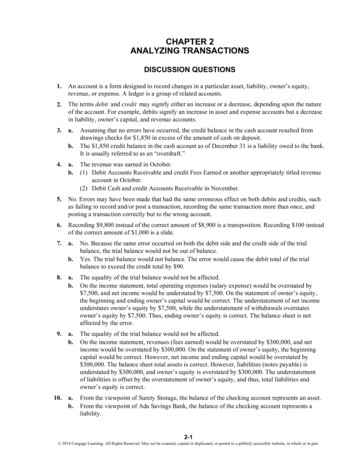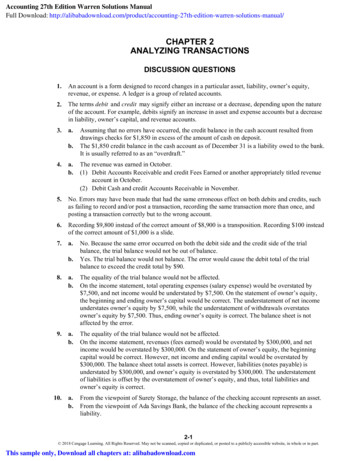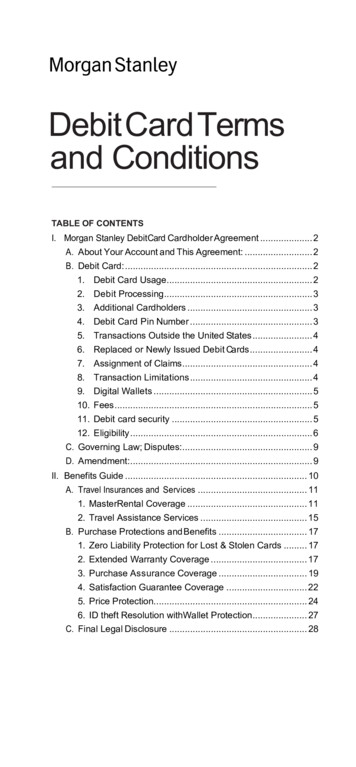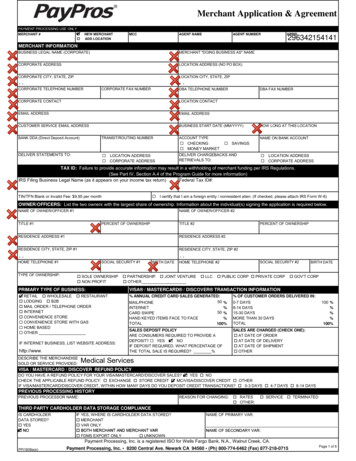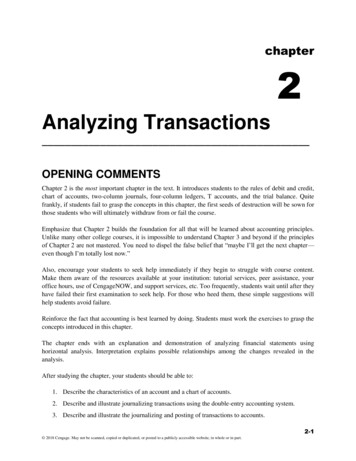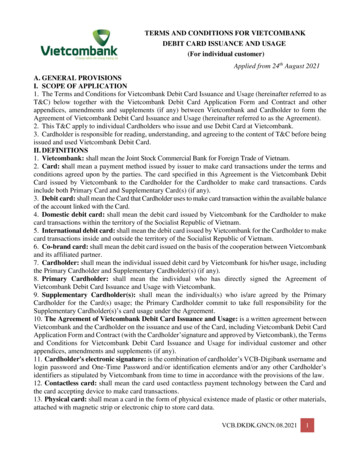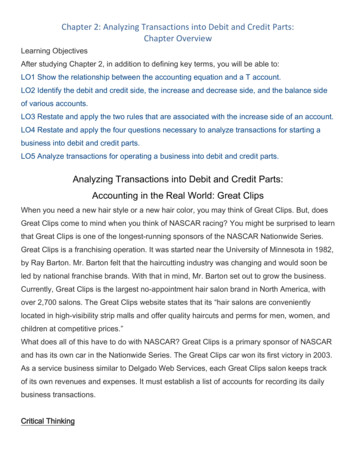
Transcription
Chapter 2: Analyzing Transactions into Debit and Credit Parts:Chapter OverviewLearning ObjectivesAfter studying Chapter 2, in addition to defining key terms, you will be able to:LO1 Show the relationship between the accounting equation and a T account.LO2 Identify the debit and credit side, the increase and decrease side, and the balance sideof various accounts.LO3 Restate and apply the two rules that are associated with the increase side of an account.LO4 Restate and apply the four questions necessary to analyze transactions for starting abusiness into debit and credit parts.LO5 Analyze transactions for operating a business into debit and credit parts.Analyzing Transactions into Debit and Credit Parts:Accounting in the Real World: Great ClipsWhen you need a new hair style or a new hair color, you may think of Great Clips. But, doesGreat Clips come to mind when you think of NASCAR racing? You might be surprised to learnthat Great Clips is one of the longest-running sponsors of the NASCAR Nationwide Series.Great Clips is a franchising operation. It was started near the University of Minnesota in 1982,by Ray Barton. Mr. Barton felt that the haircutting industry was changing and would soon beled by national franchise brands. With that in mind, Mr. Barton set out to grow the business.Currently, Great Clips is the largest no-appointment hair salon brand in North America, withover 2,700 salons. The Great Clips website states that its “hair salons are convenientlylocated in high-visibility strip malls and offer quality haircuts and perms for men, women, andchildren at competitive prices.”What does all of this have to do with NASCAR? Great Clips is a primary sponsor of NASCARand has its own car in the Nationwide Series. The Great Clips car won its first victory in 2003.As a service business similar to Delgado Web Services, each Great Clips salon keeps trackof its own revenues and expenses. It must establish a list of accounts for recording its dailybusiness transactions.Critical Thinking
1.If you owned a Great Clips franchise, why might you support Great Clips'sponsorship of NASCAR racing?2.What asset and liability accounts might a Great Clips salon use to record its transactions?List at least two transactions that a Great Clips salon might record.Analyzing Transactions into Debit and Credit Parts:Key Terms T account chart of accounts debit accounts payable credit accounts receivable normal balanceLesson 2-1: Using T Accounts LO1 Show the relationship between the accounting equation and a T account. LO2 Identify the debit and credit side, the increase and decrease side, and the balanceside of various accounts. LO3 Restate and apply the two rules that are associated with the increase side of anaccount.Analyzing the Accounting Equation LO1In Chapter 1, the effects of transactions were recorded in an accounting equation. Thisprocedure is not practical in an actual accounting system. Because of the number of accountsused by most businesses, recording transactions in the accounting equation would becumbersome. Therefore, a separate record is commonly used for each account. Theaccounting equation can be represented as a T, as shown below.The values of all things owned (assets) are on the left side of the accounting equation. The
values of all equities or claims against the assets (liabilities and owner's equity) are on theright side of the accounting equation. The total of amounts on the left side of the accountingequation must always equal the total of amounts on the right side. Therefore, the total of allassets on the left side of the accounting equation must always equal the total of all liabilitiesand owner's equity on the right side.A record summarizing all the information affecting a single item in the accounting equation isknown as an account. Transactions change the balances of accounts in the accountingequation. Accounting transactions must be analyzed to determine how account balances arechanged. An accounting device used to analyze transactions is called a T account .There are special names for amounts recorded on the left and right sides of an account. Anamount recorded on the left side of an account is called a debit . An amount recorded on theright side of an account is called a credit . The words debit and credit come from the Latin andItalian words debere and credere. Common abbreviations are dr. for debit and cr. for credit. Itis important to understand that in an accounting system, the words debit and credit do nothave the same meaning as in everyday life. In an accounting system, the terms mean onlythe left side or right side of an account.Debit means an amount recorded on theleft side of an account. Credit means anamount recorded on the right side of anaccount.Increases, Decreases, andBalances in Accounts LO3The sides of a T account are used toshow increases and decreases in account
balances. The increase side of each kind of account can be associated with the accountingequation using two rules:1. Assets are on the left side of the accounting equation. Therefore, assets increase onthe left, or debit, side of the account.2. Liabilities and the owner's capital account are on the right side of the accountingequation. Therefore, liabilities and the owner's capital account increase on the right, orcredit, side of the account.The side of the account that is increased is called the normal balance of the account. Assetshave normal debit balances because they increase on the debit side. Liabilities and theowner's capital account have normal credit balances because they increase on the creditside.Accounts decrease on the side opposite their increase side. Therefore, assets decrease onthe right, or credit, side of the account. Liabilities and the owner's capital account decrease onthe left, or debit, side of the account.End of Lesson Review LO1 Show the relationship between the accounting equation and a T account. LO2 Identify the debit and credit side, the increase and decrease side, and the balanceside of various accounts. LO3 Restate and apply the two rules that are associated with the increase side of anaccount.Terms Review T account credit debit normal balanceAudit Your Understanding1.Draw the accounting equation on a T account.2.What are the two accounting rules that explain increases of account balances?Work Together 2-1Determining the increase and decrease and the normal balance sides for accountsWrite the answers to the following problems in the Working Papers. Your instructor will guide
you through the following examples.CashAccounts Receivable—Sullivan CompanySuppliesPrepaid InsuranceAccounts Payable—Sawyer SuppliesAccounts Payable—Oceanside SuppliesParker Vogel, CapitalFor each account, complete the following:1. Prepare a T account.2. Label the debit and credit side.3. Draw an up arrow ( ) on the increase side.4. Draw a down arrow ( ) on the decrease side.5. Label the normal balance side.On Your Own 2-1Determining the increase and decrease and the normal balance sides for accountsWrite the answers to the following problems in the Working Papers. Work this problemindependently.CashAccounts Receivable—White CompanyAccounts Receivable—Jagerstrom Inc.SuppliesPrepaid InsuranceAccounts Payable—West End HardwareShelley Feinstein, CapitalFor each account, complete the following:1. Prepare a T account.2. Label the debit and credit side.
3. Draw an up arrow ( ) on the increase side.4. Draw a down arrow ( ) on the decrease side.5. Label the normal balance side.Ethics in Action: Ethics versus MoralityEthics and morality—these words are often used to refer to an individual's ability to “do whatis right.” These synonymous English words were derived from different languages. “Ethics” isderived from Greek, and “morality” is derived from Latin. Over time, our society has given aslightly different meaning to each word.Over 100 years ago, C. C. Everett wrote, “Ethics is the science of morality.” Morality is thestandard of conduct that is acceptable in a society. Ethics is an organized method that relieson our morality to make moral decisions. Science students learn the scientific method—amodel that guides how a proper experiment should be conducted. In the same manner, manyethical models have been proposed to guide individuals in applying their morality to businessdecisions.The following ethical model will be used in this textbook:1. Recognize you are facing an ethical dilemma.2. Identify the action taken or the proposed action.3. Analyze the action.a. Is the action illegal?b. Does the action violate company or professional standards?c. Who is affected, and how, by the action?4. Determine if the action is ethical.InstructionsPrepare a short report that contrasts the ethical model with the scientific method. How are themodels similar? How are they different?Think Like an Accountant: Planning for College and BeyondJohn Melby wants to be sure that he has enough money to send his newborn son to college.
His college of choice is estimated to cost 100,000 for a four-year education, including tuition,books, room, and board. John wants to know whether a 5,000 annual contribution to acollege fund will grow to 100,000 when his son enters college at the age of 18. The moneywould be invested in an account that is not subject to income taxes as long as the money willbe used to pay educational expenses.Open the Spreadsheet TLA CH02Answer the Following Questions about the College Fund Investment:1. If John can earn a 6% annual return on the fund's investments, will he reach his 100,000 goal?1. What amount would he need to contribute each year to reach his goal?2. What annual contribution would be required if his son elects to enroll in a major thatrequires five years of coursework?3. Planning for his son's college makes John realize that he needs to begin planning forhis retirement. John is currently 25 years old and wants to have 1,000,000 in hisretirement fund when he reaches age 65.4. Answer the Following Questions about John's Retirement Fund Investment:a. If John can earn a 6% annual return on the fund's investments, how much will hehave to contribute each year to reach his goal?b. What if John waits until his son begins college to start investing in his retirementfund (age 43)? How much would John have to contribute each year to reach hisgoal?Chapter 2: Analyzing Transactions into Debit and Credit Parts:Lesson 2-2: Analyzing How Transactions Affect AccountsLesson 2-2: Analyzing How Transactions Affect Accounts LO4 Restate and apply the four questions necessary to analyze transactions forstarting a business into debit and credit parts.
Received Cash from Owner as an Investment LO4January 2. Received cash from owner as an investment, 2,000.00.The effect of this transaction is shown in the illustration. Before a transaction is recorded inthe records of a business, the information is analyzed to determine which accounts arechanged and how. Each transaction changes the balances of at least two accounts. A list ofaccounts used by a business is called a chart of accounts . The chart of accounts for DelgadoWeb Services is on page 3.When accounts are analyzed, debits must equal credits for each transaction. In addition, aftera transaction is recorded, total debits must equal total credits.The same four questions are used every time a transaction is analyzed into its debit andcredit parts.Questions for Analyzing a Transaction into Its Debit and Credit Parts1. 1 Which accounts are affected? Cash and Michael Delgado, Capital.2. 2 How is each account classified? Cash is an asset account. Michael Delgado, Capitalis an owner's equity account.3. 3 How is each classification changed? Assets increase. Owner's equity increases.4. 4 How is each amount entered in the accounts? Assets increase on the debit side.Therefore, debit the asset account, Cash. Owner's equity accounts increase on thecredit side. Therefore, credit the owner's equity account, Michael Delgado, Capital.
Paid Cash for SuppliesJanuary 2. Paid cash for supplies, 165.00.The effect of this transaction on the accounting equation is shown in the illustration. In thistransaction, two asset accounts are changed. One asset, cash, has been exchanged foranother asset, supplies. The asset account, Cash, decreases by 165.00, the amount of cashpaid out. This decrease is on the left side of the accounting equation. The asset account,Supplies, increases by 165.00, the amount of supplies bought. This increase is also on theleft side of the accounting equation.The two changes are both on the left side of the accounting equation. When changes aremade on only one side of the accounting equation, the equation must still be in balance.Therefore, if one account is increased, another account on the same side of the equationmust be decreased.Transactions must always be carefully analyzed. A transaction may affect accounts from bothsides of the accounting equation. Or, a transaction may affect accounts that are on the sameside of the accounting equation, as is true in this example. A common error is to assume thatevery transaction must affect accounts on both sides of the accounting equation.Do not attach any meaning to debit/credit other than left side/right side. Don't think of themas “good” or “bad.” Debit simply means left and credit simply means right.
Questions for Analyzing a Transaction into Its Debit and Credit Parts1. Which accounts are affected?Supplies and Cash2. How is each account classified?Supplies is an asset account. Cash is an assetaccount.3. How is each classification changed?One asset (Supplies) increases and another asset(Cash) decreases.4. How is each amount entered in the accounts?Assets increase on the debit side.Therefore, debit the asset account, Supplies. Assets decrease on the credit side.Therefore, credit the asset account, Cash.Paid Cash for InsuranceJanuary 3. Paid cash for insurance, 900.00.Paying cash for insurance is very similar to paying cash for supplies. One asset is increasedand one asset is decreased.The effect of this transaction on the accounting equation is shown in the illustration. In thistransaction, two assets are changed. One asset, cash, has been exchanged for another
asset, prepaid insurance. The asset account, Cash, decreases by 900.00, the amount ofcash paid out. This decrease is on the left side of the accounting equation. The assetaccount, Prepaid Insurance, increases by 900.00, the amount of insurance bought. Thisincrease is also on the left side of the accounting equation.Questions for Analyzing a Transaction into Its Debit and Credit Parts1. Which accounts are affected?Prepaid Insurance and Cash2. How is each account classified?Prepaid Insurance is an asset account. Cash is anasset account.3. How is each classification changed?One asset (Prepaid Insurance) increases andanother asset (Cash) decreases.4. How is each amount entered in the accounts?Assets increase on the debit side.Therefore, debit the asset account, Prepaid Insurance. Assets decrease on the creditside. Therefore, credit the asset account, Cash.Bought Supplies on AccountJanuary 5. Bought supplies on account from Canyon Office Supplies, 220.00.The effect of this transaction on the accounting equation is shown in the illustration. In this
transaction, one asset and one liability are changed. The asset account, Supplies, increasesby 220.00, the amount of supplies bought. This increase is on the left side of the accountingequation. Amounts to be paid in the future for goods or services already acquired are calledaccounts payable . Canyon Office Supplies will have a claim against some of Delgado WebServices' assets until Delgado Web Services pays for the supplies bought. Therefore,Accounts Payable—Canyon Office Supplies is a liability account. The liability account,Accounts Payable—Canyon Office Supplies, increases by 220.00, the amount owed for thesupplies. This increase is on the right side of the accounting equation.Questions for Analyzing a Transaction into Its Debit and Credit Parts1. Which accounts are affected?Supplies and Accounts Payable—Canyon Office Supplies2. How is each account classified?Supplies is an asset account. Accounts Payable—Canyon Office Supplies is a liability account.3. How is each classification changed?Assets increase. Liabilities increase.4. How is each amount entered in the accounts?Assets increase on the debit side.Therefore, debit the asset account, Supplies. Liabilities increase on the credit side.Therefore, credit the liability, Accounts Payable—Canyon Office Supplies.Paid Cash on AccountJanuary 9. Paid cash on account to Canyon Office Supplies, 100.00.The effect of this transaction on the accounting equation is shown in the illustration. In thistransaction, one asset and one liability are changed. The asset account, Cash, is decreased
by 100.00, the amount of cash paid out. This decrease is on the left side of the accountingequation. After this payment, Delgado Web Services owes less money to Canyon OfficeSupplies. Therefore, the liability account, Accounts Payable—Canyon Office Supplies, isdecreased by 100.00, the amount paid on account. This decrease is on the right side of theaccounting equation.Questions for Analyzing a Transaction into Its Debit and Credit Parts1. Which accounts are affected?Accounts Payable—Canyon Office Supplies and Cash2. How is each account classified?Accounts Payable—Canyon Office Supplies is a liabilityaccount. Cash is an asset account.3. How is each classification changed?Liabilities decrease. Assets decrease.4. How is each amount entered in the accounts?Liabilities decrease on the debit side.Therefore, debit the liability account, Accounts Payable—Canyon Office Supplies.Assets decrease on the credit side. Therefore, credit the asset account, Cash.When you decrease an account balance, record the decrease on the side opposite the normalbalance side of the account. The side opposite the normal balance side can be on the left orthe right, depending on the type of account.End of Lesson Review LO4 Restate and apply the four questions necessary to analyze transactions forstarting a business into debit and credit parts.Terms Review chart of accounts accounts payableAudit Your Understanding1.State the four questions used to analyze a transaction.2.What two accounts are affected when a business buys supplies on account?Work Together 2-2Analyzing transactions into debit and credit partsT accounts are given in the Working Papers. Your instructor will guide you through the
following examples. Jensen Cleaning Service uses the following accounts. Some of theaccounts will be explained in Lesson 2-3.CashJohn Jensen, CapitalAccts. Rec.—Johannes EricksonJohn Jensen, DrawingSuppliesSalesPrepaid InsuranceRent ExpenseAccts. Pay.—Supply DepotUtilities ExpenseTransactions:Mar. 1. Received cash from owner as an investment, 4,000.00.3. Paid cash for supplies, 95.00.4. Bought supplies on account from Supply Depot, 120.00.6. Paid cash for insurance, 250.00.9. Paid cash on account to Supply Depot, 80.00.3.Prepare two T accounts for each transaction. On each T account, write theaccount title of one of the accounts affected by the transaction.4.Write the debit or credit amount in each T account to show the transaction'seffect.On Your Own 2-2Analyzing transactions into debit and credit partsT accounts are given in the Working Papers. Work this problem independently. PlumbingSolutions uses the following accounts. Some of the accounts will be explained in Lesson 2-3.CashBrian Helfrey, CapitalAccts. Rec.—Theo MosesBrian Helfrey, DrawingSuppliesSalesPrepaid InsuranceAdvertising ExpenseAccts. Pay.—Plumbing WorldRent ExpenseTransactions:June 2. Received cash from owner as an investment, 3,500.00.4. Paid cash for insurance, 105.00.5. Paid cash for supplies, 60.00.
8. Bought supplies on account from Plumbing World, 800.00.9. Paid cash on account to Plumbing World, 500.00.1.Prepare two T accounts for each transaction. On each T account, write the account title ofone of the accounts affected by the transaction.2. Write the debit or credit amount in each T account to show the transaction's effect.Chapter 2: Analyzing Transactions into Debit and Credit Parts: Global Awareness:The Global Business DayGlobal Awareness: The Global Business DayWhen doing business internationally, time zone differences and cultural factors affect thebusiness day. For example, in Spain, the normal business day is from 9 A.M. to 8 P.M. Butmany businesses traditionally close from 2 P.M. to 5 P.M. for a long lunch or siesta. In 2006,the Spanish government implemented new working hours for all government employees. Onlyone hour is allowed for lunch, and workers go home at 6 P.M. These new hours better alignthe Spanish business day with the rest of Central Europe.Critical ThinkingIf your company has offices around the world, what methods could you use tofacilitate working together on a team project?Chapter 2: Analyzing Transactions into Debit and Credit Parts: Why Accounting?: RecordHigh Box Office Receipts Accounting Net Loss?Why Accounting?:Record High Box Office Receipts Accounting Net Loss?When you hear that a movie has broken all records for box office receipts, do youautomatically assume that everyone connected with the movie received a share of the profits?That may not be the case. The answer depends on how those profits are calculated.It is well known that some movies that have broken records for box office receipts have never
shown a profit. How could this happen? For any company, revenues minus expenses equalnet income. How those revenues and expenses are calculated has a dramatic effect on thecalculation of net income.There are three controversial costs involved in the making of a movie. (1) The cost ofproducing the movie. (2) The cost of distributing the movie. (3) The cost of advertising. Eachof these costs includes the concept of overhead. Overhead costs are the costs of running thebusiness. Overhead may include the cost of the administrative offices, electricity, heat, andpayroll. Calculating the overhead costs of a movie usually involves estimating whatpercentage of the total cost should be applied to the specific movie. The higher the overheadestimate, the lower the net profit.Actors are more often refusing to accept a percentage of net profits as part of theircompensation. Instead, they negotiate for a flat fee in place of a percentage of net profits.The next time you watch a movie, read through the credits at the end of the movie. In thelisting of the crew, you will see the names of the accountants or controller for the movie. Thenask yourself if you think the movie will ever report a net profit.Critical Thinking1.List three costs that would be included in the cost of advertising.2. Use the Internet to search for the accountants for a recent movie. List the title of themovie and the name(s) of the accountants/controller.Chapter 2: Analyzing Transactions into Debit and Credit Parts: Lesson 2-3:Analyzing How Transactions Affect Owner's Equity AccountsLesson 2-3: Analyzing How Transactions Affect Owner's Equity Accounts LO5 Analyze transactions for operating a business into debit and credit parts.Received Cash from Sales LO5
January 10. Received cash from sales, 1,100.00.Revenue increases owner's equity. The increases from revenue could be recorded directly inthe owner's capital account. However, to avoid a capital account with a large number ofentries and to summarize revenue information separately from the other records, DelgadoWeb Services uses a separate revenue account titled Sales.The owner's capital account has a normal credit balance. Therefore, increases in the owner'scapital account are shown as credits. Because revenue increases owner's equity, increasesin revenue are also recorded as credits. Therefore, a revenue account has a normal creditbalance.Questions for Analyzing a Transaction into Its Debit and Credit Parts1. Which accounts are affected?Cash and Sales2. How is each account classified?Cash is an asset account. Sales is a revenue accountthat affects owner's equity.3. How is each classification changed?Assets increase. Owner's equity increases.4. How is each amount entered in the accounts?Assets increase on the debit side.Therefore, debit the asset account, Cash. Owner's equity accounts increase on thecredit side. Revenue increases owner's equity. Therefore, credit the revenue account,Sales.
Sold Services on AccountJanuary 12. Sold services on account to Main Street Services, 500.00.The analysis for selling services on account is similar to that for selling services for cash. Theonly difference is that cash is not received at the time of the transaction. Therefore, the Cashaccount is not affected by the transaction. Amounts to be received in the future due to thesale of goods or services are called accounts receivable . This transaction increases anaccounts receivable account. The same four questions are used to analyze this transactioninto its debit and credit parts.Questions for Analyzing a Transaction into Its Debit and Credit Parts1. Which accounts are affected?Accounts Receivable—Main Street Services and Sales2. How is each account classified? Accounts Receivable—Main Street Services is anasset account. Sales is a revenue account that affects owner's equity.3. How is each classification changed? Assets increase. Owner's equity increases.4. How is each amount entered in the accounts? Assets increase on the debit side.Therefore, debit the asset account, Accounts Receivable—Main Street Services.Owner's equity accounts increase on the credit side. Revenue increases owner'sequity. Therefore, credit the revenue account, Sales.Owner's equity is recorded on the right side of the accounting equation. The right side of a T
account is the credit side. Therefore, owner's equity has a normal credit balance.Paid Cash for an ExpenseJanuary 12. Paid cash for communications bill for cell phone and Internet service, 80.00.Expenses decrease owner's equity. The decreases from expenses could be recorded directlyin the owner's capital account. However, to avoid a capital account with a large number ofentries and to summarize expense information separately from the other records, DelgadoWeb Services uses separate expense accounts.The titles of Delgado Web Services' expense accounts are shown on its chart of accounts.The expense account, Communications Expense, is used for all payments for cell phonecharges.The owner's capital account has a normal credit balance. Decreases in the owner's capitalaccount are shown as debits. Therefore, an expense account has a normal debit balance.Because expenses decrease owner's equity, increases in expenses are recorded as debits.All expense transactions are recorded in a similar manner.Questions for Analyzing a Transaction into Its Debit and Credit Parts1. Which accounts are affected?Communications Expense and Cash2. How is each account classified? Communications Expense is an expense account that
affects owner's equity. Cash is an asset account.3. How is each classification changed? Owner's equity decreases from an increase inexpenses. Assets decrease.4. How is each amount entered in the accounts? Owner's equity accounts decrease onthe debit side. An increase in expenses decreases owner's equity. Expense accountshave normal debit balances. Therefore, debit the expense account, CommunicationsExpense. Assets decrease on the credit side. Therefore, credit the asset account,Cash.Received Cash on AccountJanuary 16. Received cash on account from Main Street Services, 200.00.The effect of this transaction on the accounting equation is shown in the illustration. In thistransaction, two asset accounts are changed. One asset, cash, has been exchanged foranother asset, accounts receivable. The asset account, Cash, increases by 200.00, theamount of cash received. This increase is on the left side of the accounting equation. Afterthis receipt of cash, Main Street Services owes less money to Delgado Web Services. Theasset account, Accounts Receivable—Main Street Services decreases by 200.00, theamount of cash received on account. This decrease is also on the left side of the accountingequation.
Questions for Analyzing a Transaction into Its Debit and Credit Parts1. Which accounts are affected?Cash and Accounts Receivable—Main Street Services2. How is each account classified? Cash is an asset account. Accounts Receivable—MainStreet Services is an asset account.3. How is each classification changed? One asset (Cash) increases and another asset(Accounts Receivable—Main Street Services) decreases.4. How is each amount entered in the accounts? Assets increase on the debit side.Therefore, debit the asset account, Cash. Assets decrease on the credit side.Therefore, credit the asset account, Accounts Receivable—Main Street Services.Paid Cash to Owner for Personal UseJanuary 16. Michael Delgado withdrew equity in the form of cash, 350.00.Withdrawals decrease owner's equity. Withdrawals could be recorded directly in the owner'scapital account. However, to avoid a capital account with a large number of entries and tosummarize withdrawal information separately from the other records, Delgado Web Servicesuses a separate withdrawing account titled Michael Delgado, Drawing.When drawing T accounts to analyze transactions, stack the accounts instead of writingthem horizontally. Stacking the accounts will make it easier to recognize debits and credits.
Questions for Analyzing a Transaction into Its Debit and Credit Parts1. Which accounts are affected?Michael Delgado, Drawing and Cash2. How is each account classified?Michael Delgado, Drawing is an owner's equityaccount. Cash is an asset account.3. How is each classification changed?Owner's equity decreases from an increase inwithdrawals. Assets decrease.4. How is each amount
debit credit normal balance chart of accounts accounts payable accounts receivable Lesson 2-1: Using T Accounts LO1 Show the relationship between the accounting equation and a T account. LO2 Identify the debit and credit side, the increase and decrease side, and the balance side of various accounts.
